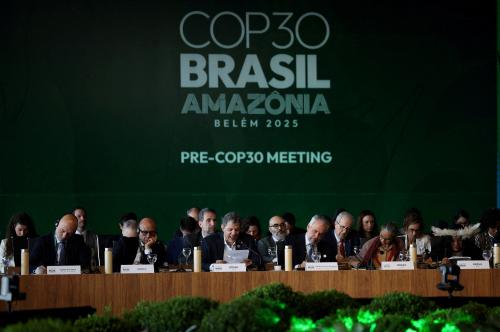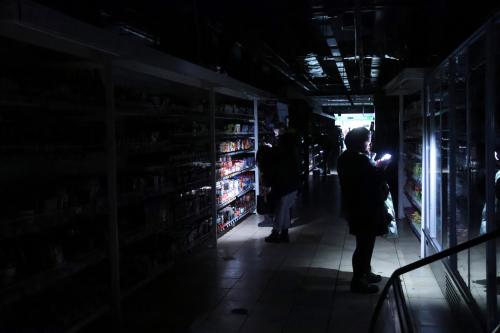From November 10-21, the 2025 United Nations Climate Change Conference, also known as the Conference of the Parties (COP30), will take place in Belém, Brazil. Below, Brookings scholars assess potential outcomes from COP30.
China’s bid for climate leadership
China sees clean technology as central to its top national and international objectives: the push for “high-quality development,” technological innovation, energy security, and global prestige. The development and deployment of clean technology, from electric vehicles and batteries to wind and solar, have been woven into China’s core industrial plans for years, including the most recent 15th Five-Year Plan proposals. Now, at a time when the United States is pulling back sharply on climate action, China is doubling down on its effort to become the world’s preeminent “electrostate” and supplier of green goods. In addition, China’s strength in clean technology powers its progress across a host of emerging technologies, from artificial intelligence and robotics to drones and autonomous vehicles.
However, China is also facing some challenges in its pursuit of climate goals. China is undergoing major power sector reform, shifting from long-term, fixed-price contracts to a more market-based system. The International Energy Agency expects China’s renewable energy deployment to slow down slightly due to lower profitability for new projects—although this will likely improve capacity utilization rates. As Chinese clean tech manufacturers expand abroad, other countries and regions like the European Union are asking whether Chinese firms are willing to localize supply chains and share technology. Meanwhile, China has been expanding its export controls on battery technology. Lastly, China’s recent 2035 Nationally Determined Contribution targets disappointed some observers, although others point to Beijing’s strategy of under-promising and over-delivering. While China is expected to portray itself as a climate leader at COP30, there will likely be many questions to follow.
US opposition to climate justice requires a bold global response
Ahead of COP30, the geopolitics of climate action have dramatically shifted. While other nations are planning dialogues to progress climate finance and a just transition, U.S. leadership is planning on not attending. But in absentia, the United States isn’t becoming irrelevant, quite the reverse. The Trump administration is positioning the United States as the leader of the opposition to a green global economy and pressuring other nations to abandon decarbonization as well.
For nations already experiencing debilitating climate shocks, the stakes couldn’t be higher. In October, The Lancet released a global stocktake of climate change’s impacts on health. Reviewing the work of 128 experts from 71 institutions, the report presents the clearest evidence yet of the relationship between climate change and worsening health. Heat-related deaths alone, for example, have increased by 63% since the 1990s to 546,000 annually between 2012 and 2021.
At COP28 in 2023, progress was made. Parties agreed “to transition away from fossil fuels.” The United Nations chief, António Guterres, announced the beginning of the end for fossil fuels. At COP30, parties can give that language power by adopting the Belém Action Mechanism, a proposed institutional arrangement to adopt a common framework for a fast, fair, and financed transition from oil, gas, and coal. This would also build momentum for the First International Conference for the Phase Out of Fossil Fuels in Colombia in 2026.
The United States has often been a bulwark, not an ally, for a just transition. However, these recent policy shifts present a substantially more interventionist position. Other nations will need to be bold and move in concert to continue progress.
Ahead of COP, Brazil focuses on forest protection
At the upcoming COP, Brazil intends to strongly highlight its renewed leadership on tropical forest preservation at home and abroad as a core mechanism for mitigating climate change. Brasília’s international engagement emphasizes its new creation—the still mostly underfunded Tropical Forests Forever Facility. In its domestic efforts, Brazil can show off decreased deforestation rates in the Amazon and the Cerrado (Brazil’s savannas) since President Luiz Inácio Lula da Silva returned to office in 2021, particularly after the free-for-all deforestation during the Jair Bolsonaro government. Although Brazil’s domestic progress will be spotlighted at COP30, it is fragile and incomplete, as my research in Brazil in June and August 2023 and September 2025 shows.
In the Amazon, Lula has implemented important rulings by Brazilian courts to combat illegal logging and mining in seven indigenous reserves. The operations involve hundreds of airborne soldiers dropping into the reserves to destroy equipment and chase out illegal loggers and miners. But because of limited law enforcement resources, the deployed troops stay for just a few weeks. Then the loggers and miners return, protected and encouraged by powerful local political interests and the Primeiro Comando da Capital, Brazil’s potent criminal group. Illegal logging conducted through fake licenses and fictitious timber-harvesting plans mostly escapes both Brazil’s law enforcement and European and U.S. regulatory actions.
Both regulations and law enforcement are even weaker in the Cerrado, another ecosystem critically important for mitigating climate change. A massive natural carbon sink and one of Brazil’s most degraded biomes, it faces enormous agricultural pressures. Over half of Brazil’s deforestation takes place there. The richly biodiverse biome is also crucial for the healthy functioning of the Amazon and hydrological systems across Brazil. But despite the high importance of its climate and ecosystem services, it receives far less conservation focus and legal protection than the Amazon. And although there are many trees in the Cerrado, it doesn’t fall within the “forest” label of Europe’s Regulation on Deforestation-free Products, and thus misses out on those protections too. Redressing those deficiencies at COP30 and beyond is imperative.
Look for deals rather than promises at the COP
COP30 in Brazil marks the 10th anniversary of the Paris Agreement, and the third time that countries are expected to make commitments about reducing their greenhouse gas emissions and other actions to limit the impact of climate change. But this recommitment point comes at a difficult time for climate diplomacy—the Trump administration is withdrawing the United States from the agreement, Europe is still recovering from the energy and economic crisis brought about by Russia’s cutoff of natural gas supply, and the world seems more focused on economic competitiveness than green transition. These factors don’t tell a happy story, and indeed the United Nations Environment Programme declared in its recent Emissions Gap Report that nations remain far from meeting emissions reduction goals.
Despite these headwinds, I expect some positives to come out of Brazil. Much of the progress in recent meetings has occurred outside the main negotiating room, where project developers, financiers, and governments can collaborate to make real change happen. Those discussions will continue, including in meetings that began on November 3 among business leaders in São Paulo and leaders of subnational governments in Rio de Janeiro, in advance of the formal negotiations. Renewable energy sources’ low cost and energy security benefits make them attractive investments, even if the formal COP negotiations get bogged down. Additionally, growing demand for electricity from AI and data centers requires rapid development of new electricity generation—a need that renewables are well-suited to meet. As the COP progresses, I’ll be watching for investments as a sign of progress.
Caring services are an essential part of climate adaptation and resilience
As the world advances toward COP30 in Brazil, a crucial yet often overlooked component of climate adaptation is a comprehensive care services infrastructure. Investing in a comprehensive care services infrastructure, which rests on formal professional care with universal coverage through affordable, accessible, and high-quality services and decent jobs for the care workforce, can help build resilience among families and communities. While most Nationally Determined Contributions (NDCs), National Adaptation Plans (NAPs), and climate finance assessments incorporate health and education services and infrastructure, they often ignore early childhood care and education and long-term care. A comprehensive care services infrastructure is itself a climate adaptation strategy that enables families and communities to prepare for, withstand, and recover from climate-related shocks.
Deficiencies in paid care services and infrastructure are widespread in countries around the world, forcing women and girls to take on more unpaid caregiving responsibilities, diminishing their economic productivity, and extending their workdays. The increased frequency and severity of climate disasters only intensify the need for paid and unpaid care. At the same time, climate disasters damage care facilities, interrupt services, and stretch an already undervalued and understaffed paid care workforce. Care work acts as a hidden but essential “shock absorber” when disasters hit, especially in the context of insufficient public funding.
COP30 provides an opportunity to prioritize care within the climate adaptation agenda. This involves incorporating early childhood and long-term care into NDCs and NAPs, estimating the costs of training and employing care workers, upgrading and greening care facilities, and enhancing digital and administrative capacities to sustain services during crises. It also means directing adaptation finance to local governments and community providers who understand how climate risks actually disrupt care on the ground.
What is at stake at COP30 is whether climate policy continues to overlook care systems that are essential to adaptation, resilience, and economic development.
COP is the New UNGA
The United Nations’ annual climate conference, now in its 30th year, continues to reflect changing global power dynamics—shedding light on unique attributes of 21st-century multilateralism.
In 1945, a group of large powers, those who had prevailed in World War II, set the rules of the road, including by designating five countries as U.N. Security Council veto holders. At COP, thanks to its consensus-based decisionmaking norms, medium-sized states—and their small state supporters—enjoy significant influence. Whether bigger or smaller carbon emitters, resource-rich or resource-poor, small island states or the world’s largest ones, COP’s participants enjoy at least the veneer of equal status.
In the first decades after the establishment of the United Nations and the Bretton Woods institutions, public actors were expected to resolve debates about international trade, international law, and global norms in multilateral arrangements. At COP, by contrast, the private sector is ever-present and highly vocal, while trade relations that span across the public and private spheres are often determinant. That’s why corporations, including those from America’s vast renewable energy sector, will flock to COP again this year. Unfortunately, Trump administration officials, having decided to boycott COP30, will not be present in order to promote these American businesses interested in gaining global market footholds.
If past is precedent, this year at Belém, Brazil, the Global South will use its influence—and the power of its numbers—to continue to demand compensation for loss and damages from more developed countries, mainly in the form of fulfilling the developed countries’ commitments to the climate finance fund. Climate justice at COP is understood as reparative and collective—focusing on specific communities and societies. This differs from the original concept of universal human rights—and its focus on the individual—that was so central to the foundation of the United Nations system in the 20th century.
How COP negotiation groups in Belem emerge still remains an unknown. If the BRICS bloc of developing countries, led by their Brazilian host, begins to negotiate as a group during the formal negotiations track, then we will see yet another sign that a new age of multilateralism has formally arrived.
Can COP30 deliver on its ambitious goals?
Every time the curtain rises on a COP, one of the most important questions is: what will get done? Usually, the answer is: not much. This year, the host country (Brazil) has set a wide array of goals, but the most difficult ones concern funding. Last year at COP29 in Baku, nations agreed to boost annual climate financing to $300 billion; the “Baku-to-Belém” roadmap is, somehow, supposed to help deliver.
Brazil has also created its own Tropical Forest Forever Facility aimed at protecting the Amazon and other special places. Brasília has committed to match the $25 billion still to be raised from governments—it has already pledged the first $1 billion itself—and leveraging three times that amount from private investors. Most governments aren’t feeling rich these days, and with so many demands for new finance, there will be a lot of griping about inadequate funding. The Amazon is in the grips of a long drought and has long struggled with rampant cutting, including around Belém, which means that there will be no shortage of evidence for why good funding mechanisms are worthy. But worthiness does not automatically unlock cash.
More important to watch, in my view, is the mood after the event. I have been warning for years that, as these COPs take on nearly impossible tasks, one will fail to get any final agreement. That will harm the invaluable legitimacy of the Paris Agreement process. There are many calls for a reset on climate policy, and there are too many impractical climate goals already. But a reset, done badly, would cause more harm than good. The day after Belém closes is not the time to start planning a smart reset.
The Brookings Institution is committed to quality, independence, and impact.
We are supported by a diverse array of funders. In line with our values and policies, each Brookings publication represents the sole views of its author(s).













Commentary
What will COP30 mean for climate action?
Brookings experts weigh in
November 10, 2025